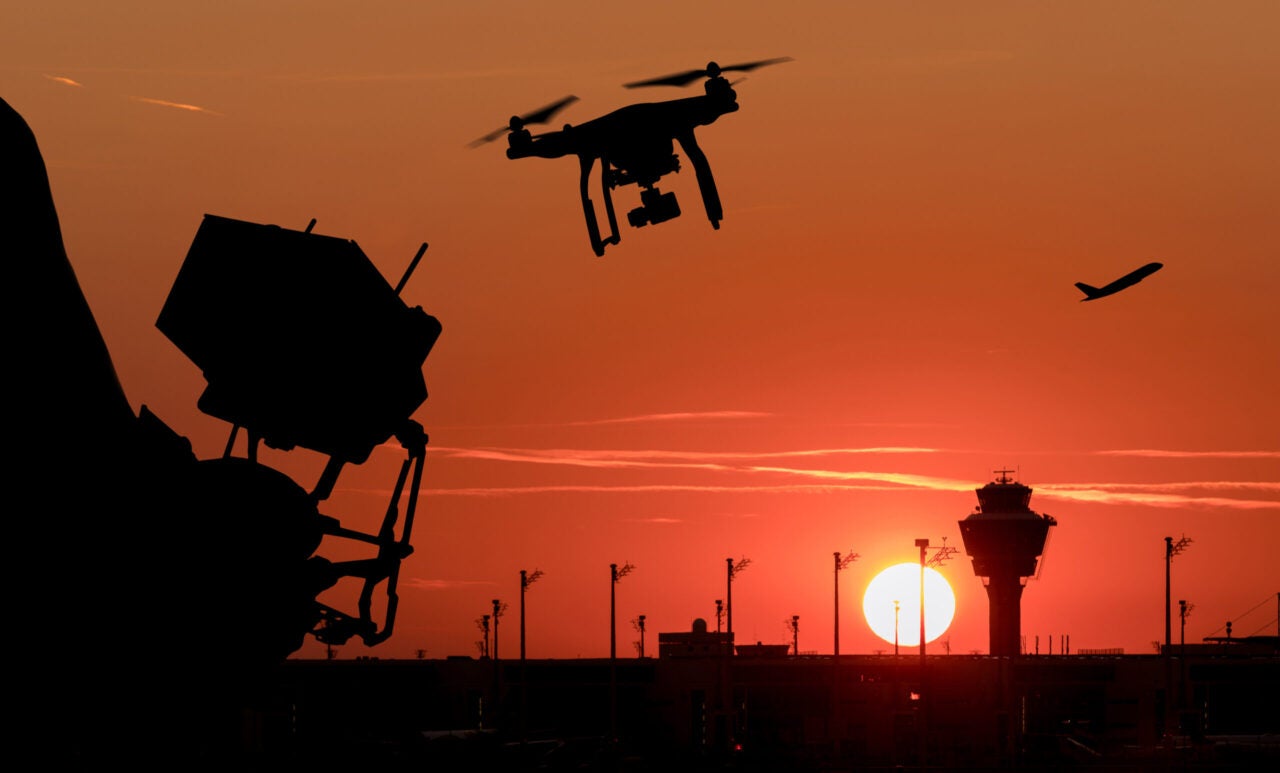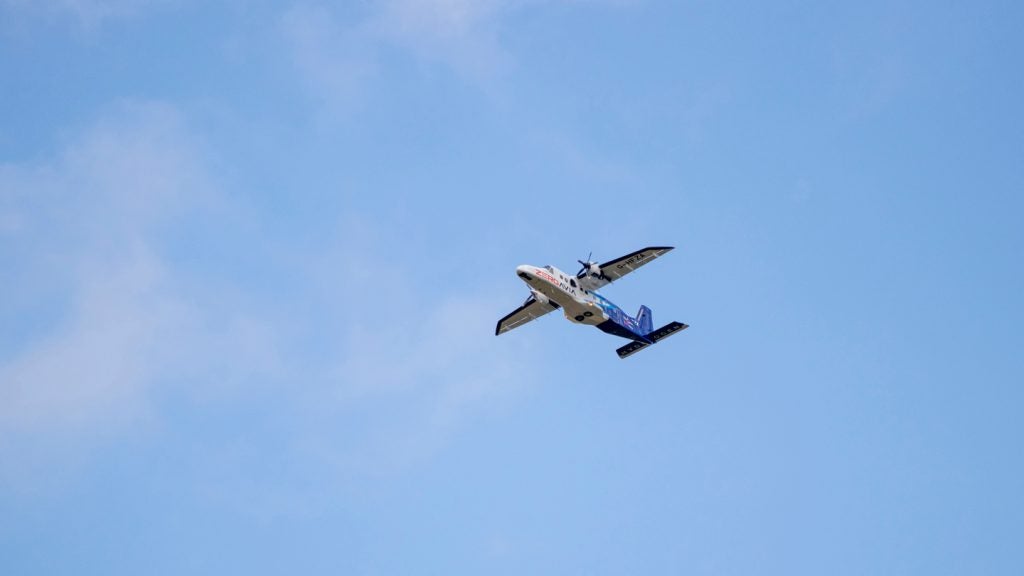
Counter-drone technology has become an essential asset for airport security. Anti-drone solutions specialist Dedrone predicts the upcoming drone landscape this year and how this will impact airports and airlines globally.
Shortly after 9 pm on 19 December 2018, a Gatwick Airport security officer reported seeing two drones in the vicinity of the airport’s perimeter fence. Within minutes, it spiralled into one of the more notorious drone airport incidents to date. The airport was closed, leaving over 140,000 passengers stranded and 1,000 flights impacted.
Drones pose a serious threat to the aviation industry from flight delay, cancellation, stranded passengers and serious economic turmoil for airlines across the globe. US counter-drone security company Dedrone offers the aviation industry technology to detect and classify drones and identify operators. The company also provides real-time alerts and identification information for the aviation industry.
Frankie Youd speaks with Dedrone head of aviation, Americas, Jackson Markey about the company’s drone landscape predictions for this year and the issue of drone regulations varying between counties.
Frankie Youd: What does your role entail?
Jackson Markey: As Dedrone’s head of aviation, my focus is to stay up-to-date on the quickly evolving environment of drones and counter-drone capabilities, regulations and uses in the aviation industry and ensure my clients have the essential information to make important business decisions for the safe operation of their airport with respect to drones.
Drones and the consequent airspace security solutions are relatively new industries, especially when considering that physical security dates back thousands of years. As a result, the rules and regulations are constantly changing.
How well do you really know your competitors?
Access the most comprehensive Company Profiles on the market, powered by GlobalData. Save hours of research. Gain competitive edge.

Thank you!
Your download email will arrive shortly
Not ready to buy yet? Download a free sample
We are confident about the unique quality of our Company Profiles. However, we want you to make the most beneficial decision for your business, so we offer a free sample that you can download by submitting the below form
By GlobalDataStaying on top of these developments is essential to remain a trusted advisor to our clients and ensure they are making the best decisions for the safety and security of their airlines, passengers, employees, and operations.
This requires discussion with key stakeholders across various different businesses and regulatory bodies ranging from the Federal Aviation Administration (FAA) and local law enforcement to third-party technology partners.
What are your predictions for the drone landscape this year?
We predict that the laws protecting airports against unauthorised drones will strengthen. Stronger laws will give police more power to apprehend pilots of unauthorised drones while at the same time, drone analytics will be used to provide evidence against the pilots and complete criminal cases.
Rapid response is key to catching these pilots and in 2022 more and more airports will finally acquire the technology to do so.
Additionally, while some think of us as a “counter-drone” company, we are very pro-drone. Our goal is to ensure the safe integration of drone technology into the National Airspace System through the development of Airspace Security and Unmanned Aircraft System Traffic Management strategies.
With that in mind, we think of ourselves as an airspace security company rather than a counter-drone company and we are looking forward to when Remote ID goes into full effect for drone manufacturers in September 2022.
This new standard will require all drones to broadcast essential identification information for the FAA, law enforcement and other federal agencies to locate drones and drone operators who are flying in an unsafe manner.
How do these predictions impact the aviation/airport environment?
As laws strengthen and data improves, you will see more awareness of drone threats beyond the airport security teams.
These laws combined with the increased information from airspace security solutions and Remote ID requirements will enable the aviation industry to clearly demonstrate the danger presented by drones and give law enforcement the information and capability to address this new threat.
Airports will now easily detect, track and locate drones and pilots. For example, if a hobbyist is unaware they are in a no-fly zone near an airport, local law enforcement can quickly locate the pilot and approach them regarding the risks of flying around an airport.
Similarly, if a drone detection solution detects a drone not broadcasting remote ID, it is an immediate red flag that this pilot may be nefarious and trying to fly undetected.
What specific challenges does the aviation industry face from drones?
While the aviation industry is greatly challenged by the accessibility and easy operation of drones, they will also benefit greatly from them. So much so that the FAA’s BEYOND programme, which started in 2020, is focusing on developing rules and collecting data to streamline the approval process for UAS integration into aviation environments.
That said, nothing better demonstrates the challenges drones present to the aviation industry than the 2018 London Gatwick drone incident. For those not familiar, an unauthorised drone shut down airport operations for 36 hours cancelling 1,400 flights, stranding 100,000 plus passengers and costing the airport approximately $65,000,000.
To think a $500 drone could wreak so much havoc demonstrates the significant safety, security, and financial risk of drones to the aviation industry.
How do drone regulations differ worldwide?
The most challenging aspect of drone regulations is that because they are still such a new technology, there are very few regulations at all around the globe. Those that do exist vary greatly.
For example, mitigation is a very hot topic in the industry right now. Some nations allow mitigation technologies like jamming which severs the communication between the drone and remote control forcing the drone to safely land or return to the operator.
At the same time, other countries, like the US, do not allow the use of mitigation technology due to potential collateral damage. This is an issue that will need to be debated by various stakeholders at all levels of government to make significant progress.
What hurdles do organisations like the FAA currently face in defining drone regulations?
To reiterate an earlier point, because drone technology is changing so rapidly, it is very challenging to develop regulations that keep up with this quickly evolving technology.
For a recent example, 5G phones created concerns near airports, now we have 5G drones! According to the FAA, drones are still offered the same protections as aeroplanes in the US! Clearly some level of differentiation is required!
Dedrone believes drone technology will continue to be a valuable tool for organisations around the world to increase safety and security and streamline business operations.







